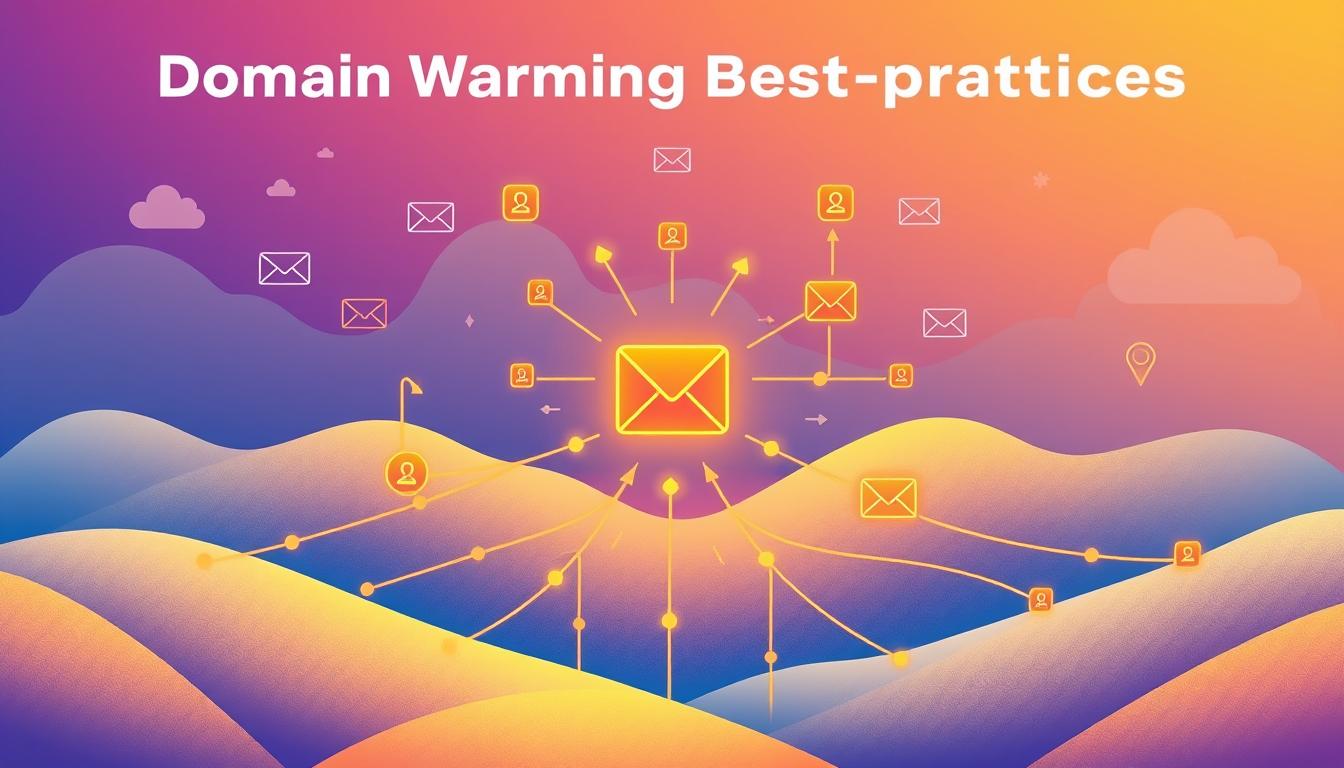In the world of email marketing, domain warming is key to success. It helps businesses and marketers get their emails delivered. This article will guide you on how to build trust with email providers and improve your inbox placement.
It will also cover managing your sender reputation and using IP warming techniques. These steps are crucial for better email deliverability rates.
Key Takeaways
- Establish trust with email providers to improve inbox placement rates
- Understand the impact of email sender reputation on deliverability
- Implement gradual email volume increases and monitor engagement metrics
- Leverage IP warming techniques to ensure optimal email deliverability
- Maintain email list hygiene through regular cleaning and subscriber segmentation
The Significance of Domain Warming
Domain warming is key for email senders to gain trust from email providers. It helps them get their messages to the inbox. By slowly sending more emails and watching how people interact with them, senders can build a good Email Sender Reputation. This makes their emails more likely to land in the inbox.
Establishing Trust with Email Providers
Email providers watch how senders act to make sure they send good emails. Domain warming shows senders follow best practices. This means they keep their email lists clean, follow anti-spam rules, and send valuable content.
Improving Inbox Placement Rates
When senders gain trust, their emails are more likely to go to the inbox. This better Inbox Placement Optimization means more people will open and click on their emails. This leads to more engagement and success for their campaigns.
| Metric | Pre-Domain Warming | Post-Domain Warming |
|---|---|---|
| Inbox Placement Rate | 70% | 85% |
| Open Rate | 20% | 30% |
| Click-Through Rate | 5% | 10% |
The table shows how domain warming can boost important email metrics. It shows why this practice is so important for email senders.
Understanding Email Sender Reputation
Your email sender reputation is key to how email providers treat your messages. A good reputation means your emails land in the inbox. But a bad one can mark them as spam. We’ll look at what affects your reputation and how to keep it positive.
Engagement rates are a big part of your email sender reputation. If people open, click, and reply to your emails, providers see you as trustworthy. But, lots of spam complaints, bounces, and unsubscribes can hurt your reputation a lot.
Keeping your email list clean and up-to-date is also crucial. Sending to people who didn’t ask to receive your emails can harm your email sender reputation.
| Factors Impacting Email Sender Reputation | High Reputation | Low Reputation |
|---|---|---|
| Engagement Rates | High open, click-through, and response rates | High bounce, spam complaint, and unsubscribe rates |
| Email List Quality | Clean, opt-in subscriber list | Outdated, purchased, or unengaged recipients |
| Authentication Protocols | Proper SPF, DKIM, and DMARC implementation | Lack of email authentication measures |
| Sender Domain and IP Reputation | Consistent, positive sending history | Irregular or poor sending patterns |
To keep a good email sender reputation, you need to do several things. Focus on keeping your email list clean, improving engagement, and using the right authentication. This way, your emails will always reach the inbox and you’ll gain trust from both your audience and email providers.
https://www.youtube.com/watch?v=9k8R9QYcn_U
Warming Up Your Domain: Best Practices to Maximize Email Deliverability
Warming up your domain is key to getting your emails into your recipients’ inboxes. By slowly sending more emails and watching how people interact with them, you show email providers your domain is reliable. You also prove your content is interesting to your audience.
Gradual Email Volume Increase
Begin by sending a few emails and then send more over time. This slow increase helps email providers see if your domain is real and trustworthy. It also boosts your chances of getting your emails into the inbox. Don’t send too many emails at once, as this can make providers think something is wrong.
Monitoring Engagement Metrics
Keep an eye on how well your emails do by looking at open rates, click-through rates, and bounce rates. Use this info to make your emails better. This means improving your content, subject lines, and who you send emails to. Always be ready to change your strategy based on what you learn.
| Metric | Ideal Range | Significance |
|---|---|---|
| Open Rate | 20-30% | Shows how much your audience cares about your emails. |
| Click-Through Rate | 5-10% | Tells you if your emails are getting people to take action. |
| Bounce Rate | Less than 5% | Helps find and fix problems with your email list. |
By using these email warmup and inbox placement optimization tips, you can make sure your messages get to your subscribers’ inboxes.
IP Warming Techniques
In email marketing, IP warming is key to a good sender reputation and better email delivery. It means sending more emails from one IP address slowly. This helps email providers see the sender as reliable and trustworthy.
Dedicated IP vs Shared IP
Businesses can choose between dedicated or shared IP addresses for warming. Each has its own benefits and drawbacks, based on the company’s needs and resources.
- Dedicated IP Address: A dedicated IP is for one sender or company only. It gives more control and customization. But, it costs more and needs more upkeep.
- Shared IP Address: A shared IP is used by many senders. It’s cheaper but gives less control over the IP’s reputation. Proper warming is key to keep the reputation good.
| Dedicated IP | Shared IP |
|---|---|
| Exclusive control over the IP’s reputation | Lower cost |
| Ability to customize IP warming strategy | Less control over IP’s reputation |
| Higher cost | Potential impact from other shared users |
| Requires more maintenance | Simpler to manage |
Whether it’s a dedicated or shared IP, a good warming plan is vital. It ensures emails get delivered well and builds a strong sender reputation.

Email Throttling: A Crucial Step
In the world of email marketing, email throttling is key. It helps you send more emails slowly, so email providers can check your content’s quality. This shows you care about sending valuable messages, which can get your emails into more inboxes.
Throttling has many benefits. It builds trust with email providers, making your messages seem real and safe. It also boosts your sender reputation, which is vital for getting your emails to the inbox, not the spam folder.
- Start with a low email volume and gradually increase it over time.
- Monitor your engagement metrics, such as open rates and click-through rates, to ensure your content is resonating with your audience.
- Adjust your throttling strategy based on the feedback and performance of your campaigns.
By using email throttling, you can improve your email delivery. A good throttling plan is not just a good idea. It’s essential for successful email marketing.
“Email throttling is the key to building a strong sender reputation and maximizing your email deliverability.”
Email List Hygiene
Keeping your email list clean and active is key to better email delivery. Email List Hygiene means cleaning your list and segmenting subscribers. These steps are vital for boosting your email marketing.
Regular List Cleaning
Your email list can grow old and include inactive subscribers. This can hurt your sender reputation and email performance. Cleaning your list regularly removes these inactive contacts. This way, you only talk to people who are really interested and active.
By doing this, you can see better email delivery, open rates, and click-through rates. It’s all about keeping your list fresh and engaged.
Subscriber Segmentation
Good email marketing is more than just sending emails to everyone. Segmenting your subscribers helps you send more relevant content. This makes your emails more interesting and effective.
Segmenting can be based on many things like where they are, how active they are, or what they like. This way, you can send emails that really speak to each person.
Some common ways to segment include:
- Geographic location
- Engagement levels (e.g., active, inactive, new subscribers)
- Purchase history or browsing behavior
- Demographic factors (e.g., age, gender, job title)
- Subscriber preferences and interests
With a solid Email List Hygiene plan, you can keep your list healthy and active. This means your emails will reach the right people at the right time. And that leads to better results for your email marketing.
Email Authentication Protocols
Keeping your email communications safe and reliable is key. Email authentication protocols like SPF, DKIM, and DMARC help a lot. They check if your emails are real and stop fake ones from getting through.
SPF, DKIM, and DMARC Explained
Sender Policy Framework (SPF) lets you control who can send emails from your domain. It stops fake emails from looking like they’re from you.
DomainKeys Identified Mail (DKIM) adds a special code to your emails. This code proves your email is real and hasn’t been changed while it was sent.
Domain-based Message Authentication, Reporting, and Conformance (DMARC) works with SPF and DKIM. It tells email services what to do with emails that don’t pass checks. It also sends you reports on your email activity.
Using these Email Authentication Protocols makes your emails more trustworthy. It helps your reputation as a sender and gets your messages to the right inbox more often.
| Protocol | Purpose | Benefits |
|---|---|---|
| SPF | Verifies the authorized email servers for your domain | Prevents email spoofing and unauthorized use of your domain |
| DKIM | Adds a digital signature to outgoing emails | Ensures message integrity and helps receivers verify the sender’s identity |
| DMARC | Specifies how email providers should handle messages that fail authentication checks | Improves email deliverability and provides valuable insights into email activity related to your domain |
“By implementing Email Authentication Protocols, you can build trust with email providers and significantly enhance the deliverability of your email messages.”
Avoiding Spam Filters
Creating email content that avoids spam filters is key to getting your messages seen. Content optimization is a big part of this. By tweaking your subject lines, body text, and image use, you can dodge spam filters and land in the main inbox.
Subject Line Optimization
Your email’s subject line is your first chance to impress. It’s crucial in deciding if your email gets opened or goes to spam. Stay away from words like “free,” “limited time,” or “act now.” Instead, aim for short, clear, and interesting subject lines.
Body Copy Considerations
Your email’s body should be easy to read, full of useful info, and fun to read. Don’t overdo it with all-caps or too many exclamation marks. Also, keep your images and text balanced to avoid spam flags.
- Avoid excessive use of all-caps, exclamation points, or other attention-grabbing tactics
- Maintain a balanced image-to-text ratio to prevent triggering spam filters
- Ensure your content is informative, engaging, and provides value to your recipients
By optimizing your email content and following best practices, you can effectively avoid spam filters. This boosts your email’s deliverability. The secret is to know what email providers like and tailor your content to meet those needs.

Monitoring and Adjusting Your Warm-Up Strategy
Effective domain warming is an ongoing process. It needs constant monitoring and adjustments. To make sure your warm-up strategy works, you must regularly check your email metrics. Look at your open rates, click-through rates, and bounce rates to find areas to improve.
By watching these metrics closely, you can make smart changes to your warm-up strategy. If your open rates drop, it might be time to change your email content or subject lines. If your bounce rates are too high, it could mean your email list needs cleaning up.
Warming up a domain is not a one-time job. It’s a process that keeps getting better with each change. Be ready to adjust your sending schedule, email content, or who you send emails to as needed.
By being alert and quick to act on data, you can keep your domain warming efforts effective. Keep a close eye on your metrics. Be ready to change your strategy to keep your email deliverability rates high and boost your email marketing success.
Email Deliverability Rates: Measuring Success
Tracking your domain warming efforts is key to better email marketing. By watching Email Deliverability Rates, you can improve your email reach. This boosts your communication’s impact.
To see how well your domain warming works, look at these important metrics:
- Inbox Placement Rates: Shows how many emails land in the inbox, not spam.
- Deliverability Percentages: This includes both inbox success and bounce rates.
- Campaign Performance: Check open rates, click-through rates, and conversion rates to see how well your emails do.
By keeping an eye on these Email Deliverability Rates, you can spot what needs work. This data helps you fine-tune your warm-up plan. It ensures your emails get to the right people, making your messages more effective.
“Improving your Email Deliverability Rates is crucial for the success of your email marketing campaigns. Closely monitor these metrics to make informed decisions and optimize your strategy.”
Conclusion
Domain warming is key to better email delivery and reaching your audience. Following the best practices in this guide helps. This includes starting slow, managing your reputation, warming up your IP, and keeping your email list clean.
Keep working on your email deliverability. By always checking and tweaking your warm-up plan, you can keep your sender reputation strong. Using Email Warmup, managing your Email Deliverability Rates, and improving your Email Sender Reputation are all important. They help you succeed in the changing world of email marketing.
Keep improving your email marketing and focus on Inbox Placement Optimization, Avoiding Spam Filters, and keeping your email list healthy. This will help you use the best practices to maximize email deliverability and connect with your audience better. Remember, your email deliverability is crucial for your marketing success. So, put in the time and effort to get it right.
FAQ
What is domain warming and why is it important for email deliverability?
Domain warming means slowly sending more emails to build trust with email providers. This helps your emails get to the inbox more often. It’s key for better email delivery.
How can I establish trust with email providers through domain warming?
Start by sending fewer emails and then send more over time. Watch how people interact with your emails. This shows your content is worth reading.
What factors influence my email sender reputation?
Your reputation is based on how many emails you send, how people interact with them, and if anyone complains. Keeping a good reputation helps your emails reach more people.
What are the best practices for warming up my domain?
Slowly send more emails and keep an eye on how people react. Make sure your list is clean and engaged. Also, use email security like SPF and DKIM.
How do I effectively warm up my IP address?
Warming up your IP means sending more emails from it slowly. This shows it’s trustworthy to email providers.
What is email throttling, and why is it a crucial step in the domain warming process?
Email throttling means sending more emails slowly. This lets providers check if your emails are good. It shows you care about sending quality content.
How can I maintain a clean and engaged email list to improve deliverability?
Keep your list clean by removing inactive subscribers. Segment your list to send better content to each group. This helps your emails get through.
What email authentication protocols should I set up, and how do they improve deliverability?
Use SPF, DKIM, and DMARC to show your emails are real. This makes providers trust your emails more, improving delivery.
How can I avoid having my emails flagged as spam?
Make your emails look good by optimizing subject lines and content. This helps avoid spam filters.
How do I monitor and adjust my domain warming strategy?
Always check your email metrics to see how you’re doing. Use this info to make your strategy better. Adjust based on feedback from providers and your audience.
How can I measure the success of my domain warming efforts?
Track important metrics like how many emails get to the inbox. This helps you see what’s working and what’s not. Use this info to keep improving your emails.


